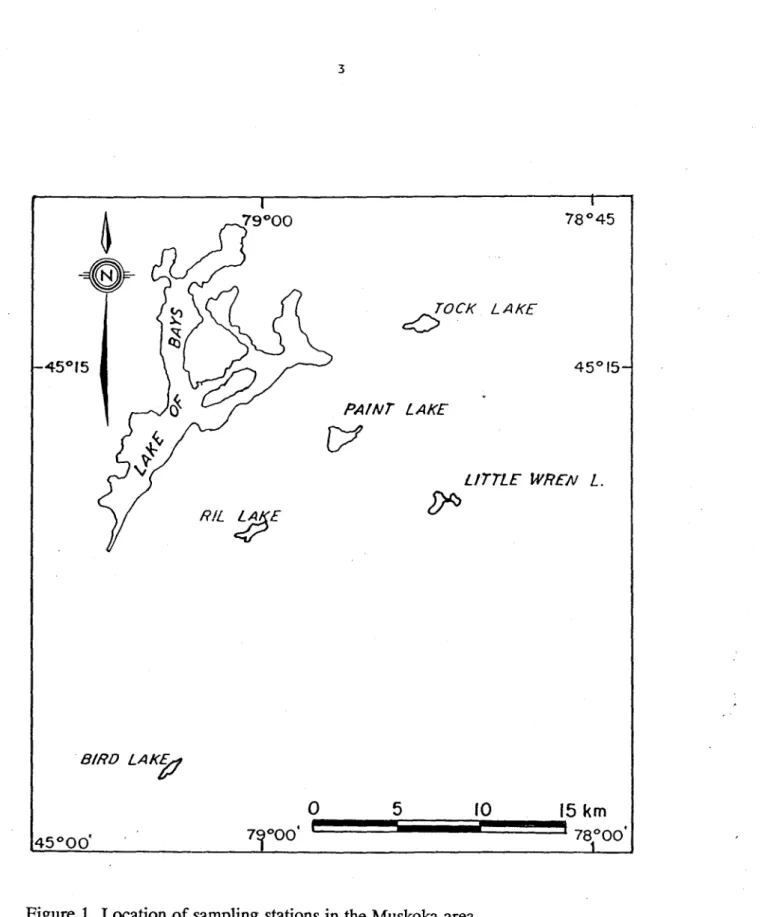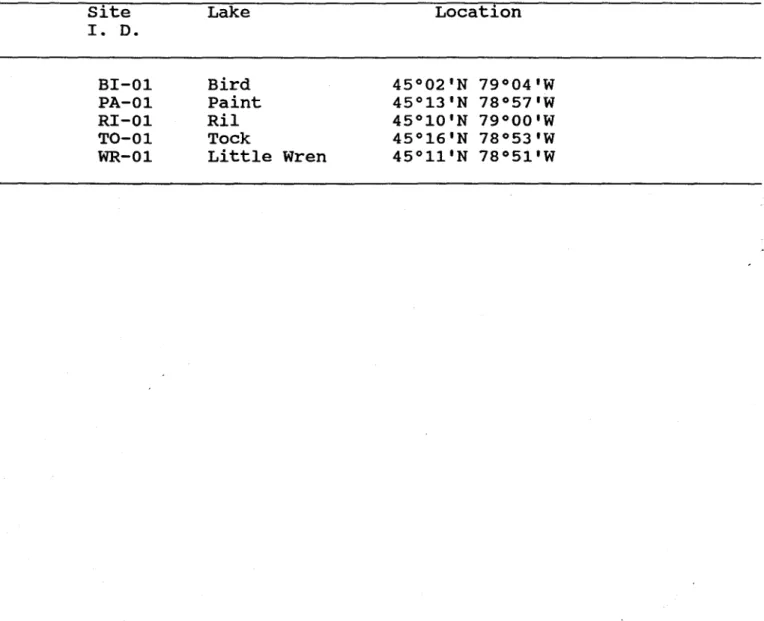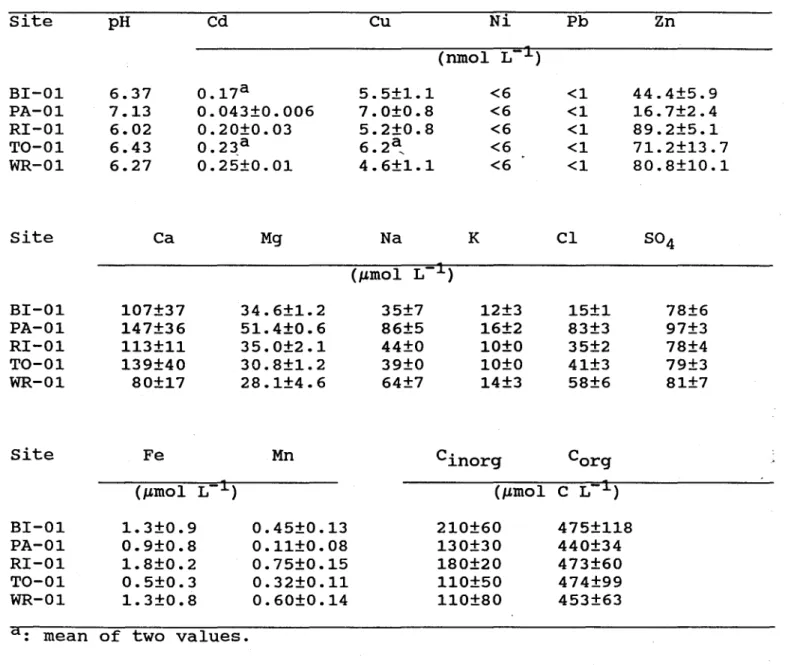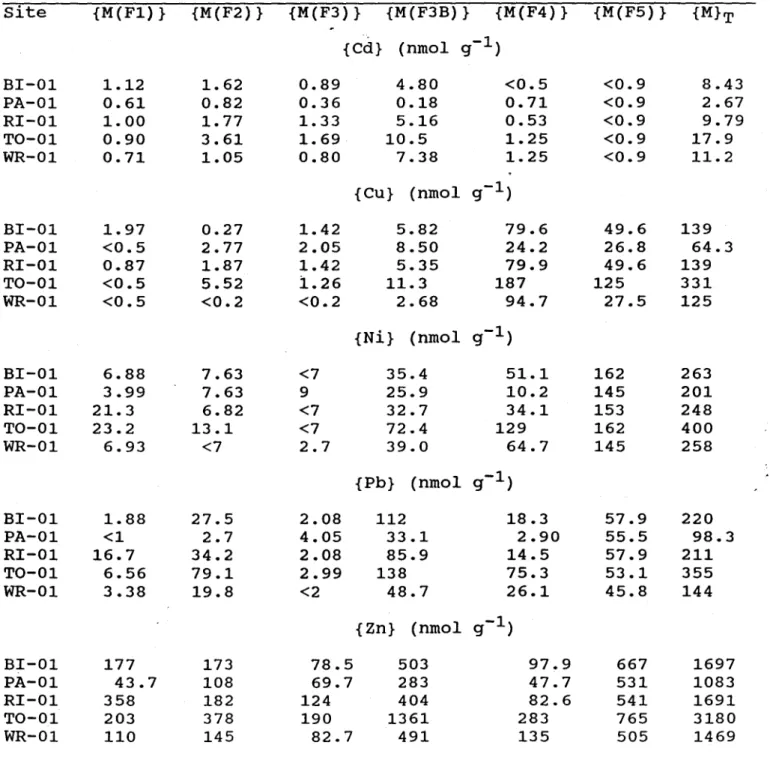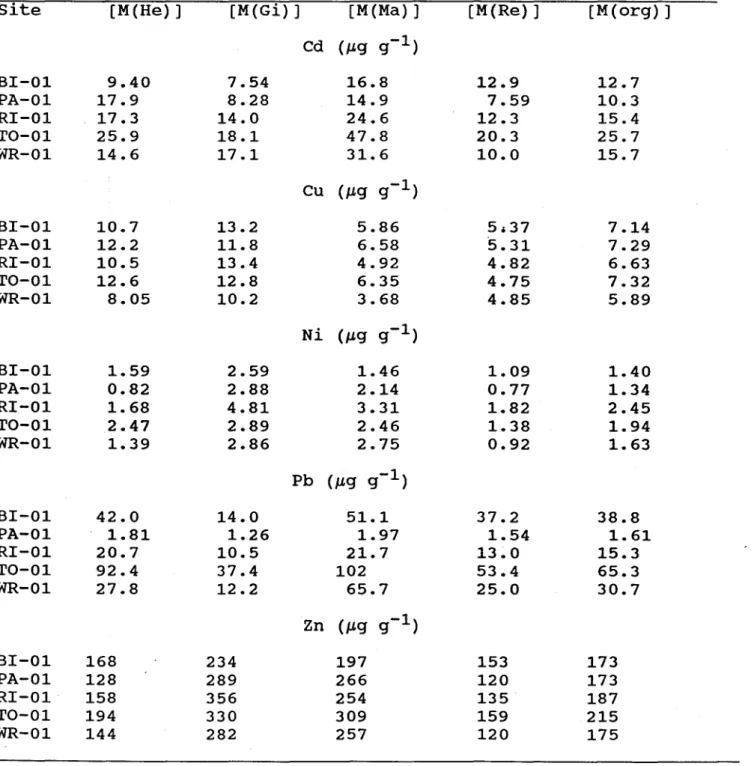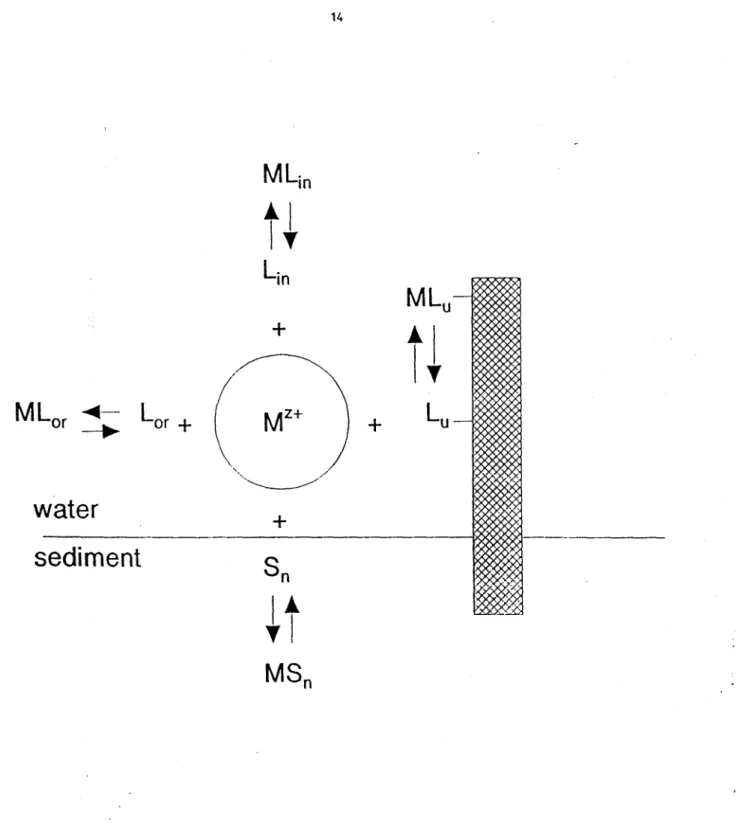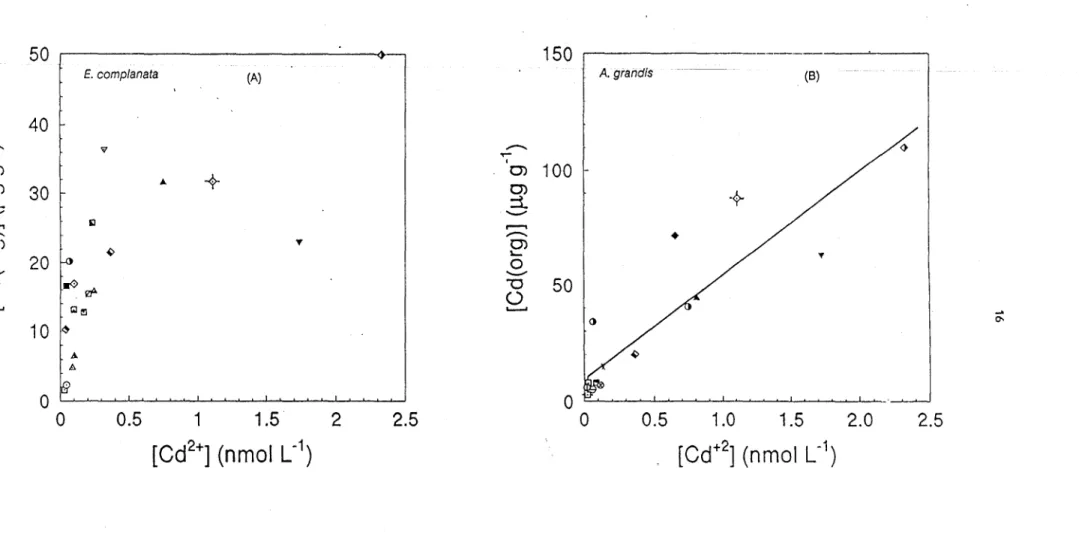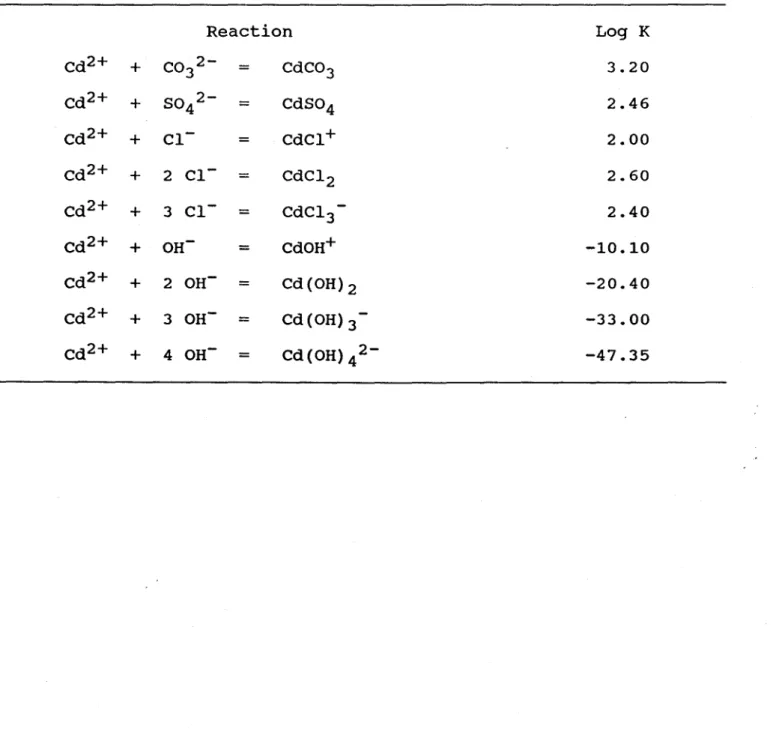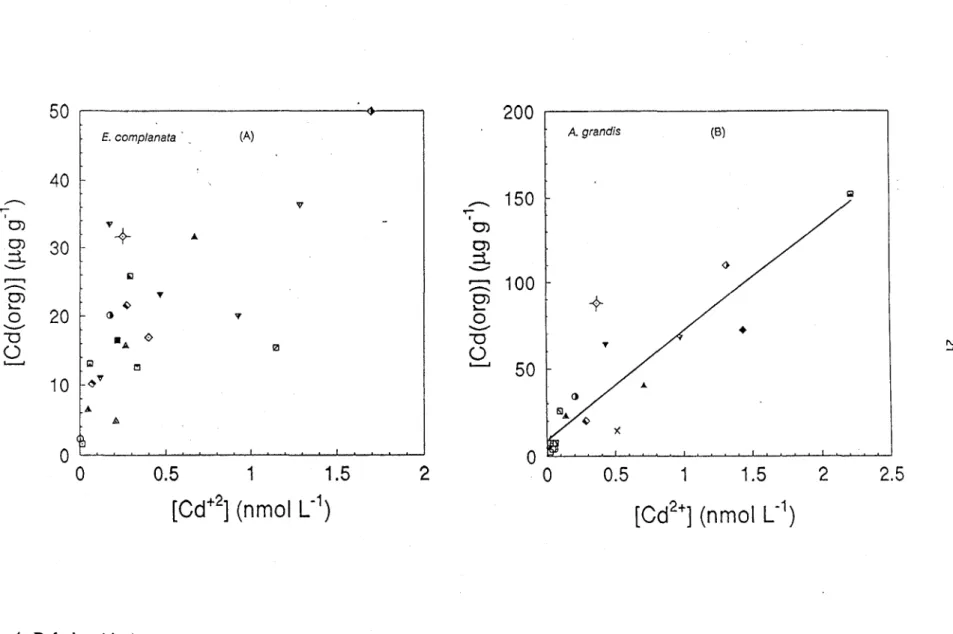1.
INTRODUCTION.
ABIOTIC FACTORS INVOLVED IN
PREDICTING TRACE METAL LEVELS
IN FRESHWATER BIVALVES
A. Tessier and P.G.C. campbell
Industrialization has led to increasing fluxes of trace metals from terres trial and atmospheric
sources towards the aquatic environ ment. Mining operations and metal refining and processing
industries are important point sources of trace metals.
In
certain parts of the world (Eastern
Canada), atmospheric deposition also represents an important direct contribution of trace
metals to surface waters; the concomitant acidic de position may also lead to increased
mobilization ·of trace metals from terres trial sources to the aquatic system. As-a result of
complex physical, chemical and biological processes, most of the trace metals introduced into
the aquatic environment are found associated with the bottom sediments, where they constitute
a potential danger for benthic organisms.
Management of in-place contaminants is one of the major problems confronted by
governmental agencies responsible for the protection of the environ ment. In principle, remedial
actions such as reduction in waste disposal, chemical treatment of in-place contaminants,
capping or dredging can be undertaken; these actions are however costly.
It
is clear that the
development of rational, effective and economical strategies to solve the problem posed by
sediment-bound toxic metals will depend greatly on our ability to predict how remedial actions
will improve water quality and how these changed conditions will affect aquatic organisms.
Important progress in this direction will be made only by understanding the biogeochemical
processes governing metal accumulation by benthic organisms under field situations.
Abstract
We have developed and tested in the field a deterministic model to
predict metal accumulation in benthic organisms. In the formulation of
the model, we used concepts derived from the free-ion activity model
of metal-organism interactions and from surface complexation theory,
to relate metal concentrations in the organisms to those in the water
or in the surficial oxic sediments.
The model was successfully tested in the field for cadmium
accumulation in the freshwater bi valve
Anodonta grandis.
Linear
regression analysis indicated that Cd concentrations in the soft
tissues of the bivalve, [Cd(org)], are related to the free cadmium
concentrations, [Cd2
+],
estimated from the total dissolved Cd and
inorganic ligands concentrations: [Cd(org)]
=
44 [Cd2
+] +
10
(r2=0.81). In a further step, partitioning of cadmium between water
and surficial oxic sediments was interpreted, using surface
complexation concepts, in terms of sorption of this metal on two
sediment components: organic matter and iron oxyhydroxides. This
partitioning model relates the free Cd2
+ concentrations to sedimentary
variables (e.g:, total sedimentary Cd, iron oxyhydroxides and organic
carbon concentrations) and water pHi sedimentary variables can then be
model, based on well accepted theories, to predict metal accumulation in benthic organisms.
The idea behind this development was that such a model, because of its mechanistic basis,
should be of general applicability (i.e. it should apply to sites others than those used in the
model calibration). The specific objectives were: i) to derive predictive equations for trace metal
concentrations
in
bivalves that are valid for any aquatic environment where these organisms
can be found;
li)
to evaluate the utility of the bivalves as bioindicators for trace metals. By
coupling concepts from the free-ion model of trace metal organisms interactions with the
surface complexation theory, we have made substantial progress towards this general
objective, using Cd as our test metal.
2. MATERIAL AND METHODS.
2.1. Study area.
The sediments, associated porewater samples and bivalve specimens were collected at
littoral stations in lakes located
in
the Muskoka area, Ontario (Table 1; Figure 1). They lie on the
Precambrian Shield. The c10sest areas of industrial activities are Sudbury
(~200
km
northwest)
and Toronto
(~250km
south).
2.2. Sampling.
The interstitial and overlying water samples were obtained with
in situ
samplers (porewater
peepers; 1 cm vertical resolution; 3 per lake) similar to those described by Hesslein (1976) and
Carignan
et al.
(1985). The peepers were filled with demineralized water and bubbled with
nitrogen for at least 24 h in plexiglass cylinders filled with demineralized water before being
inserted vertically in the lake sediments by a diver. After a two week equilibration period, the
peepers were retrieved from the sediments by a diver; samples were collected immediately
from five compartments above and five below the water-sediment interface, and pH was
measured in each sample (Carignan, 1984). Samples for dissolved sulfate and chloride analysis
were removed from the peepers with a syringe and injected into prewashed polypropylene
tubes; those for inorganic carbon determinations were obtained with a syringe and injected
through a septum into pre-evacuated and pre-washed glass tubes. The samples for the
PA/NT LAKE LITTLE WREN L. RIL ~E
!Y>
B/RD LAKf:1o
5
fO
7 000'Table 1. Sample identification and location of .sampling stations in
the Muskoka area.
site
l . D.Bl-01
PA-01
Rl-01
TO-01
WR-01
Lake
Bird
paint
Ril
Tock
Little
Location
45°02'N 79°04'W
45°13'N 78°57'W
45°10'N 79°00'W
45°16'N 78°53'W
Wren
45°11'N 78°51'W
analysis of trace metals were collected by piercing the membrane (Gelman HT-2oo, 0.2
J.Lmnominal pore size) with a Gilson pipette fitted with acid cleaned tips: these samples were
injected into pre-washed and pre-acidified (30 uL of IN Ultrex
HN0
3,final pH
<
2.5) Teflon
Rvials. Additional water was collected from the compartments 6 and 7 cm above the
sediment-water interface of each peeper (combined content 5 mL) for analysis, if necessary, by multiple
injection in flameless atomic absorption spectrophotometry (see below). On severa! occasions
during the summer, water samples were also collected by divers at many of the sites with a
clean polyethylene bottle close to the sediment-water interface for pH measurement. The
purpose of this measurement was to calculate time-averaged pH values (-log (L[H+]/n)) for the
summer period.
Sediment cores (4-5 per site) were collected by a diver, close to the peepers, with plexiglass
tubes (9 cm diameter). The tubes were tightly closed to minimize perturbations of the sediments
during their transport to the shore. The sediment cores were extruded on the shore, and only
the uppermost half centimeter, containing oxidized sediments, was retained. These samples
were placed in 500 mL centrifugation bottles half filled with lake water, and kept at ::::4
0C during
transport to the laboratory where they were kept frozen until analysis.
Specimens of
Elliptio complanata
(10 per site) were obtained by a diver at each site, within a
radius of :::: 50 m from the sediment and porewater collection site. The bivalves were placed in
plastic bags with lakewater and maintained at:::: 4 oC during transport to the laboratory where
they were left to depurate for at least 24 h in aerated lake water. They were then dissected into
gills, mantle, hepatopancreas and remaining tissues, hereafter referred to as "remains". For
each sampling site, individual tissue types from the ten animals collected were pooled and
frozen at -20 oC until needed for analysis.
2.3 Analyses.
The water samples were analyzed for Cd, Cu, Ni, Pb, Zn, Fe, Mn,
S04' Cl, major cations and
organic and inorganic carbon. The metal concentrations were obtained by flame atomic
absorption spectrophotometry (AA) when possible (Fe, Mn, Ca, Mg, Na, K; Varian Techtron,
Model575ABQ or Model Spectra AA-20) or, otherwise, by flameless AA (Fe, Mn, Cd, Cu, Ni,
Pb, Zn; Varian Techtron, Model1275 or Spectra AA-30; GTA-95 or GTA-96). When initially
of five times the analytica1 detection limit (0.13 nmol L-I), its concentration was determined by a
multiple injection technique. The necessary number of aliquots were injected successively and
subjected to the preliminary drying steps; the combined sample was then atomized. The
detection limits for Ni and Pb were not improved with this technique. The National Research
Council of Canada (NRC) Riverine Water Reference Material (SLRS-2) was analysed for Cd, Cu
and Zn; we obtained 0.024+0.003
J1.g
Cd L-I (N=4; certified value 0.028+0.004
J1.g
Cd VI),
2.96+0.13
J1.g
Cu L-I (N =6; certified value 2.76+0.17
J1.g
L-I) and 3.38±0.07
J1.g
Zn L-l (N =7;
certified value 3.33+0.15
J1.g
L-l). The National Bureau of Standards Reference Materiall643b
(Trace Eleme~ts
in Water) was analyzed after lOX to 40X dilutions for Pb; we obtained:
25.7+2.4
J1.g
Pb L-l (N=4; certified value 24.1 +0.7
J1.g
Pb L-I). Sulfate and chloride
concentrations were determined by ion chromatography (Dionex Autolon, System 12);
dissolved inorganic carbon was measured by gas chromatography (Carignan 1984) and
dissolved organic carbon by persulfate-ultraviolet oxidation, followed by conductometric
determination of the released CO2 on a Technicon aûtoanalyser.
The surficial sediment samples were thawed and centrifuged to remove excess water;
subsamples (equivalent to
~1 g dry wt.) were extracted and trace metals were partitioned into
the following empirica1 fractions (Tessier
et al.
1985): i) the sediment subsample was extracted
for 30 min with 1 N
MgC~;ii) the residue from (i) was extracted for 5 h. with
C~COONaadjusted to pH 5 with CH
3COOH;
iii)
the residue from (ii) was extracted for 30 min. at room
temperature with 0.1 M
~OH·HCI in 0.1 N HN0
3;IV) the residue from (iii) was extracted for 6
h. at 96°C with 0.04 M
~OH·HCI in 25 % (v/v) CH
3COOH; v) the residue from (iv) was
extracted for 5 h. at 85°C with
~02adjusted to pH 2 with HN0
3 ,and then at room temperature
with 3.2 M NH
40Ac in 20% (v/v) HN0
3;vi) the residue from (v) was digested successively with
concentrated HN0
3(15 min; under reflux; followed by evaporation to dryness), concentrated
HCL0
4(4 mL; 60 min under reflux) and HF (15 mL; evaporation to dryness; 12-18 h) and
dissolution of the residue was effected in 50 mL of 5 % HCL. Fe, Mn, Cd, Cu, Ni, Pb and Zn
concentrations in the extracts were determined by flame or flameless AAS, using the
appropriate extractant matrices for standards and blanks. Details of these procedures are given
in earlier publications (Tessier
et al.
1979, 1985). The National Research Council of Canada
reference sample of marine sediment MESS-l has been subjected to the sequential extraction
procedure. We measured, for the sum of the six fractions: 25.2+ 1.4 J..I.g Cu g-l (N=4; certified
value 25.1 +3.8 J..I.g Cu g-l), 169+2 J..I.g Zn g-l (N=4; certified value 191 + 17 J..I.g Zn g-l),
29.6+0.9 J..I.g Pb g-l (N=4; certified value 34.07-6.1 J..I.g Pb g-l). For Cd, and Ni"which showed
10wer than detection limit values in sorne fractions, we found the following
rang~s0.56+0.07
<
x
<
0.72+0.03 J..I.g Cd g-l (N=4; certified value 0.59+0.10 J..I.g Cd g-l) and
26.0+1.5
<
x
<
28.6+2.8 J..I.g Ni g-l (N=4; certified value 29.5+2.7 J..I.g Ni g-l). Sediment organic
carbon concentrations, {C
Org}'were determined with a CNS analyzer (Carlo-Erba, Model
NA15OO) after removal of inorganic carbon by acidification with diluted H
2S0
4(0.5 mol L-l; 15
min., 100
mL/g
sediment dry weight).
Bach pooled bivalve tissue was homogenized (Brinkman tissue grinder, Model CH-6010). A
subsample was then dried to constant weight to determine the wet:dry weight ratio, and a
second subsample was digested in a Teflon bomb with concentrated nitric acid (Aristar;
3 mL g-l of tissue dry weight) in a microwave oven at pressures between 5500 and 7000 KPa for
~1 min. A certified reference material (lobster hepatopancreas, TORT-l, NRC) was submitted
to the same digestion procedure and analyzed for Cd, Cu, Ni, Pb and Zn; we obtained
24.1+0.5 J..I.g Cd g-l (N=5; certified value 26.3+2.1 J..I.g Cd g-l), 385+5 J..I.g Cu g-l (N=5; certified
value 439+22 J..I.g Cu g-l), 2.1 +0.3 J..I.g Ni g-l (N=4; certified value 2.3+0.3 J..I.g Ni g-l),
9.6+0.7 J..I.g Pb g-l (N=5; certified value 10.4+2.0 J..I.g Pb g-l) and 182+31 J..I.g Zn g-l (N=5;
certified value 177+ 10 J..I.g Zn g-l).
3.
RESULTS
The concentrations of dissolved constituents above the sediment-water interface, as
obtained with the porewater peepers, are given in Table 2. Dissolved cadmium concentrations
vary between 0.04
~d0.25 nmol L-l; these values are much lower than those reported by
Hinch and Stephenson (1987) for Beech (3 nmol L-l) and Tock (3 nmol L-
1)Lakes. For this latter
lake, we measured 0.23 nmol L-
1•Campbell and Evans (1991) measured values between 0.2
and 1.25 nmol L-l in the epilimnia of various lakes in south-central Ontario; sorne of their
sampled lakes are in the Muskoka area. We measured dissolved Cu concentrations between
4.6 and 7.0 nmol L-
1and Zn concentrations between 17 and 89 nmol L-l; these values are
Table 2. Mean concentrations (±SD) of total dissolved constituents
(Ca, Cd, Cl, Cu, Fe, Mn, Ni, Pb, s04' Zn, pH, inorganic and organic
carbon) above the sediment-water interface, as obtained with the
porewater peepers.
site
pH
Cd
Cu
Ni
Pb
Zn
(runol L- 1 )
BI-01
6.37
0.17 a
5.5±1.1
<6
<1
44.4±5.9
PA-01
7.13
0.043±0.006
7.0±0.8
<6
<1
16.7±2.4
RI-01
6.02
0.20±0.03
5.2±0.8
<6
<1
89.2±5.1
TO-01
6.43
0.23a
6.2~<6
<1
71.2±13.7
WR-01
6.27
0.25±0.01
4.6±1.1
<6
<1
80.8±10.1
site
Ca
Mg
Na
KCl
S04
(l'mol
L 1)BI-01
107±37
34.6±1.2
35±7
12±3
15±1
78±6
PA-01
147±36
51.4±0.6
86±5
16±2
83±3
97±3
RI-01
113±11
35.0±2.1
44±0
10±0
35±2
78±4
TO-01
139±40
30.8±1.2
39±0
10±0
41±3
79±3
WR-01
80±17
28.1±4.6
64±7
14±3
58±6
81±7
site
Fe
Mn
Cinorg
Corg
(l'mol L 1)
(l'mol C L- 1 )
BI-01
1.3±0.9
0.45±0.13
210±60
475±118
PA-01
0.9±0.8
0.11±0.08
130±30
440±34
RI-01
1.8±0.2
0.75±0.15
180±20
473±60
TO-01
0.5±0.3
0.32±0.11
110±50
474±99
WR-01
1.3±0.8
0.60±0.14
110±80
453±63
slightly lower than those reported by Hinch and Stephenson (1987) for Beech (16 nmol Cu VI;
77 nmol Zn L-I) and Tock (16 nmol Cu L-I; 120 nmol Zn L-I) Lakes. The concentrations of
dissolved Ni and Pb were below our detection limits ( 6 and 1 nmol L-l respectively). For these
last two metals, multiple injections did not improve detection limits.
Concentrations of sedimentary trace metals obtained in various fractions vary slightly from
one lake to another (Table 3). Comparison of sediment trace metal concentrations among lakes
or with those obtained by other researchers is difficult, since the sediment samples were
obtained from the littoral zone of the lakes, where sediment composition is often patchy. The
. results show, however, general trends that were observed in other studies (Forstner and
Wittmann, 1981). For example, non-residual Cu is found mostly in fraction F4 (between 65%
(paint Lake) and 97% (Little Wren Lake», which confirms the high affinity of natural organic
matter for Cu. Large proportions of non-residual Pb (between 47% (Tock Lake) and 87% (Paint
Lake» and non-residual Zn (between 46%
(Ril
Lake) and 64% (paint Lake» are found in the
sum of fractions F3A and F3B; similar results were reported for suspended river sediments
(Tessier
et al., 1980). The ratio {COrg}:{Fe-ox} in the sediments ({Fe-ox} is the sum of
{Fe(F3A)} and {Fe(F3B)} in Table 3) varies between 10 (paint Lake) and 130 (Little Wren
Lake); this large variation in the ratio explains at least partIy variations in metal partitioning
observed among lakes. For example, the ratio [Cu(F4)]:([Cu(F3A)]
+
[Cu(F3B)]) is linearly
correlated (r2=0.92; N=5) with the ratio {COrg}:{Fe-ox}. This strong correlation suggests a
competition between iron oxyhydroxides and organic matter for copper; such a competition
has been reported by Luoma (1986).
Concentrations of Cd, Cu, Ni, Pb and Zn in the tissue of
E. complanata are given in Table 4. We ,
found that cadmium concentrations in the tissues of the bivalve varied between 13 and
26 J.1.g g-I. These values are similar to those reported for E. complanata by Servos et al., (1987)
for Lake of Bays (12
J.1.g g-l) and by Hinch and Stephenson (1987) for Beech (11 J.1.g g-l) and
Tock (15
J.1.g g-l) Lakes. The values obtained for Cu (between 5.9 and 7.3 J.1.g g-l) and Zn
(between 170 and 215
J.1.g g-l) are similar to those reported by Hinch and Stephenson (1987) for
Beech (7.3
J.1.g Cu g-l; 155 J.1.g Zn g-l) and Tock (10 J.1.g Cu g-l; 130 J.1.g Zn g-l) Lakes.
Table 3. Partitioning(*) of trace metals in the oxic layer of lake
sediments and concentration of sedimentary organic carbon. The
concentrations are given on a dry weight basis.
site
{M(F1)}
{M(F2)}
{M(F3)}
{M(F3B)}
{M(F4)}
{M(F5)}
{M}T
{Cd} (nmol g-l)
BI-01
1.12
1.62
0.89
4.80
<0.5
<0.9
8.43
PA-01
0.61
0.82
0.36
0.18
0.71
<0.9
2.67
RI-01
1.00
1. 77
1.33
5.16
0.53
<0.9
9.79
TO-01
0.90
3.61
1. 69
10.5
1.25
<0.9
17.9
WR-01
0.71
1.05
0.80
7.38
1.25
<0.9
11.2
{Cu} (nmol g-l)
BI-01
1.97
0.27
1.42
5.82
79.6
49.6
139
PA-01
<0.5
2.77
2.05
8.50
24.2
26.8
64.3
RI-01
0.87
1.87
1.42
5.35
79.9
49.6
139
TO-01
<0.5
5.52
1.26
11.3
187
125
331
WR-01
<0.5
<0.2
<0.2
2.68
94.7
27.5
125
{Ni} (nmol g-l)
BI-01
6.88
7.63
<7
35.4
51.1
162
263
PA-01
3.99
7.63
9
25.9
10.2
145
201
RI-01
21.3
6.82
<7
32.7
34.1
153
248
TO-01
23.2
13.1
<7
72.4
129
162
400
WR-01
6.93
<7
2.7
39.0
64.7
145
258
{Pb} (nmol g-l)
BI-01
1.88
27.5
2.08
112
18.3
57.9
220
PA-01
<1
2.7
4.05
33.1
2.90
55.5
98.3
RI-01
16.7
34.2
2.08
85.9
14.5
57.9
211
TO-01
6.56
79.1
2.99
138
75.3
53.1
355
WR-01
3.38
19.8
<2
48.7
26.1
45.8
144
{Zn} (nmol g-l)
BI-01
177
173
78.5
503
97.9
667
1697
PA-01
43.7
108
69.7
283
47.7
531
1083
RI-01
358
182
124
404
82.6
541
1691
TO-01
203
378
190
1361
283
765
3180
WR-01
110
145
82.7
491
135
505
1469
Table 3. (Continue).
site
{M(Fl)}
{M(F2)}
{M(F3)}
{M(F3B)}
{M(F4)}
{M(F5)}
{M}T
{Fe} (J,Lmol g-l)
BI-Ol
0.20
8.49
6.59
95.8
10.3
413
534
PA-Ol
0.20
4.03
6.52
105
3.65
397
517
RI-Ol
0.04
8.83
9.79
73.9
10.6
380
483
TO-Ol
0.06
6.79
7.07
113
33.9
544
705
WR-Ol
0.14
7.72
7.95
63.8
24.9
344
448
{Mn} (J,Lmol g-l)
BI-Ol
0.87
1.26
2.29
1.49
0.06
9.56
15.5
PA-Ol
0.55
2.02
25.3
3.08
0.06
9.65
40.7
RI-Ol
0.69
1.24
1.97
1.04
0.05
7.88
12.9
TO-Ol
0.88
1.48
0.87
1.18
0.05
6.19
10.7
WR-Ol
1.07
0.35
0.07
0.28
0.08
9.08
10.9
BI-Ol
4472
PA-Ol
1107
RI-Ol
3230
TO-Ol
9967
WR-Ol
9358
(*):
{M(Fl)} •.... {M(F5)} represent metal concentrations in fractions 1
to 6 following the sequence given in the texte
Table 4. Metal concentrations (on a
dry
weight basis) in the tissues of
Elliptio complanata
from
various sampling sites. He, hepatopancreas; Gi, gills; Ma, mantle; Re, remaining; org, whole
organisms.
site
[M(He}]
[M(Gi}]
[M(Ma)]
[M(Re}]
[M(org}]
Cd (J1.g g-l)
BI-01
9.40
7.54
16.8
12.9
12.7
PA-01
17.9
8.28
14.9
7.59
10.3
RI-01
17.3
14.0
24.6
12.3
15.4
TO-01
25.9
18.1
47.8
20.3
25.7
WR-01
14.6
17.1
31.6
10.0
15.7
Cu (J.Lg g-l)
BI-01
10.7
13.2
5.86
5.37
7.14
PA-01
12.2
11.8
6.58
5.31
7.29
RI-01
10.5
13.4
4.92
4.82
6.63
TO-01
12.6
12.8
6.35
4.75
7.32
WR-Ol
8.05
10.2
3.68
4.85
5.89
Ni (J1.g g-l)
BI-Ol
1.59
2.59
1.46
1.09
1.40
PA-Ol
0.82
2.88
2.14
0.77
1.34
RI-Ol
1.68
4.81
3.31
1.82
2.45
TO-Ol
2.47
2.89
2.46
1.38
1.94
WR-01
1.39
2.86
2.75
0.92
1.63
Pb (J1.g g-l)
BI-Ol
42.0
14.0
51.1
37.2
38.8
PA-Ol
1.81
1.26
1.97
1.54
1.61
RI-Ol
20.7
10.5
21.7
13.0
15.3
TO-Ol
92.4
37.4
102
53.4
65.3
WR-01
27.8
12.2
65.7
25.0
30.7
Zn
(J1.g
g-l)
BI-Ol
168
234
197
153
173
PA-01
128
289
266
120
173
RI-Ol
158
356
254
135
187
TO-01
194
330
309
159
215
WR-Ol
144
282
257
120
175
4. DISCUSSION
4.1 The free-ion activity mode!.
According to the free-ion activity model (Figure 2), the effects (including bioaccumulation) of
a trace metal M on an organism which obtains the trace metal from the water should be
predicted by the free ion concentration (or activity) of this metal, [Mz+]. The concentration of a
metal accumulated into an organism, [M(org)], should thus be written (Morel, 1983):
[M(org)]
=
f([M z
+])
(1)where f means a function. This model has been developed for explaining (with great success)
biological effects of trace metals on unicellular organisms. Laboratory bioassays, conducted
with benthic animals exposed to dissolved metals under carefully controlled conditions, have
shown that the effects of trace metals on these animaIs are aIso related to the free metal ion
concentration and not to the total metal concentrations in the animaIs' environ ment. For
example, mortality of the shrimp
Palaemonetes pugio
exposed to cadmium was shown to be
related to [Cd2+] (Sunda
et al.,
1978). Similarly, short-term (14 d) accumulation of copper in the
American oyster
Crassostrea virginica
was found to be related to [Cu2+] (Zamuda and Sunda,
1982). Note, however, that the applicability of the free-ion activity model in the field, where
dissolved ligands (e.g. naturaI organic matter) differ from the synthetic ligands used in the
laboratory (e.g. NTA, EDTA), has never been demonstrated.
For the following discussion, we have focused on cadmium;
a~ongthe metals measured,
water, sediment and animal data are more complete for this metal (other metals show many
"lower than detection limit" values, especially for the water samples). To enhance the
representativity of the study, we include aIso Cd data obtained for other lakes that we have
studied, which are located in the areas of Sudbury (On), Rouyn-Noranda (Qc; mining area;
heavily contaminated with Cd), Chibougamau (Qc; mining area), Québec (Qc) and Eastern
Townships (Qc). These lakes are distributed over a geographical area of about 350 000 km
2and they represent a large gradient of Cd contamination and a wide range of pH vaIues. Since
additional measurements are needed to ob tain a satisfactory picture of Cd concentrations in
E.
+
MLor
~
Lor
+ (
MZ+
+
" -' "'~'water
+
sediment
Figure 2. Schematic representation of the various reactions occurring in the water overlying the
sediments. W+ is the free metal ion; L and L are dissolved inorganic and organic ligands
respectively;
L
is a ligand at the surface of an organism or a transport molecule; S is a
component of the sediment (e.g. iron oxyhydroxides; organic matter) which sorbs the trace
metal;
ML , ML ,ML and MS represent the metal bound to the various ligands or sediment
f i M u ncomponents.
discussion Cd data that we have obtained for another widespread freshwater bivalve,
Anodonta
grandis.
We have plotted in Figure 3 cadmium concentrations in
E.
complanata (Fig. 3a) and in A.
grandis
(Fig. 3b) as a function of [Cd
2+].We have calculated [Cd
2+]with the equilibrium model
HYDRAQL (papelis
et al., 1988), using the total dissolved Cd concentrations ([Cd]; Table 2),
the measured concentrations of the inorganic ligands concentrations (Table 2), and the stability
constants of the inorganic complexes (Smith and Martell, 1977); the stability constants used for
calculating Cd complexation are given in Table 5. Because the thermodynamic equilibrium
constants for Cd-DOM (dissolved organic matter) are unknown, possible cadmium
complexation by natural organic ligands could not be considered in the calculation.
According to the data in Figure 3b, Cd concentrations in the tissues of
A.grandis (J..Lg
g-l) can
be described by :
[Cd(org)]
=
44 (±5) [Cd2
+] +
10 (±15)
(2)(n
=
17; r 2
=
0.81; [Cd2
+]
in nmol L-1 )
The relationship between cadmium concentration in
E. complanata and [Cd
2+]is, however, not
as clear; if data from D'Alembert Lake are removed, it would resemble an hyperbolic function.
Additional measurements, especially at sites where dissolved Cd concentrations are high, are
needed before a definitive interpretation can be made.
It
might be argued that much of the scatter in Figure 3a,b is due
tovariation in dissolved Cd
on short time sca1es (Tessier
et al., 1993). For example, Yan et al. (1990) reported a 2-fold
change in dissolved Cd concentration in Red Chalk Lake during the ice-free season; this lake is
located in the Muskoka area. Dissolved Cd concentrations used in the present study are mean
values for a single sampling. Cadmium concentrations in the bivalves are probably not sensitive
to short-term variations in dissolved Cd. For example, we have observed that Cd
concentrations in the tissues of
A.grandis
specimens transplanted from the unpolluted Lake
Brompton (Eastern townships) to the polluted Lake Joannes (Rouyn-Noranda area) had not
reached, after three years, the cadmium levels observed in the indigenous specimens from
Lake Joannes. The use of time-averaged values of dissolved Cd, instead of the single values
40
--..
--..
.- ...,
100
0 ) -0 )+
::i.
, 0) 0)30
+
::i.
---
---,--, il ,--,--..
+ 0 ) ~ 0 --.. 0)..,
L. f-o ~ 020
---
---
"'050
0
"'0 JI00
l1r1 ' - - ' till!]...
10
~ () A-h.0
W
o
~.~~~~~~~~_L~~_L~0
0.5
1
1.5
2
2.5
o
0.5
1.0
1.5
2.0
2.5
[Cd
2+] (nmol L-
1), [Cd+
2](nmol L-
1)Figure 3. Relationship between cadmium concentration in the tissues (whole organisms) of
E. complanata
(A) or
A. grandis
. (B) and the free cadmium ion concentration calculated fram total dissolved Cd and inorganic ligands. Symbols represent
various sampling sites.
...
0-Table 5. stability constants used in the equilibrium model HYDRAQL
(Papelis et al., 1988) for the complexation with inorganic ligands.
Reaction
Log
KCd2 +
+
CO 2-
3
=
CdC03
3.20
Cd2 +
+
SO 2-
4
=
CdS04
2.46
Cd2+
+
CI-
=CdCI+
2.00
Cd2 +
+
2 CI-
=
CdCl 2
2.60
Cd2 +
+
3 CI-
=CdCI 3-
2.40
Cd2 +
+
OH-
=CdOH+
-10.10
Cd2 +
+
2 OH-
=Cd(OH)2
-20.40
Cd2 +
+
3 OH-
=Cd (OH) 3
-
-33.00
Cd2 +
+
4 OH-
=Cd(OH) 4 2-
-47.35
function to predict cadmium concentration in
E. complanata
(Fig. 3a). Measurement of temporal
changes in Cd concentrations in the tissues of transplanted
A.grandis
specimens suggests
that they accumulate metals only during the warm season (e.g. from May to October). For
optimum predtctive power, the mean [Cd2+] should thus be preferentially obtained for this
period.
The data shown in Figure 3 are consistent with the free-ion activity model.
It
should be noted,
however, that very similar relations would have been obtained with total dissolved Cd ([Cd]),
since its concentration at all sites is close to the computed value for [Cd
2+].Given the similarity
between [Cd
2+]and [Cd] values, and the scatter shown in Fig. 3, it is not possible with the
present data to demonstrate unambiguously that the free-ion activity model applies in the field
to Cd accumulation in
E.complanata
or
A.grandis.
To do so, one would need a natural setting
where the degree of complexation, a
=
[Cd]/[Cd2+], vary from site to site. Both
S04
and Cl are
known
tocomplex Cd, but it is unlikely that
E.complanata
and
A.grandis
would
befound in
freshwaters where these inorganic ligands are present in sufficiently high concentrations
tocomplex Cd significantly.
An
alternative approach to demonstrate the application of the free-ion
activity model to Cd accumulation by the two bivalves in the field would
be tofmd sites where
natural organic matter complexes Cd significantly, provided of course that we can account for
this complexation and correctly estimate [Cd
2+].4.2 Relationship between dissolved and surficial sedimentary Cd.
Cadmium concentrations in the surficial oxic sediments are related to dissolved Cd
concentrations in the overlying water, Le. in the bivalves' aqueous environment. The partitioning
of Cd between water and surficial oxic sediments has been interpreted, using surface
complexationconcepts, in terms of the sorption of this metal to the two following sediment
components: organic matter and iron oxyhydroxides. The development of this partitioning
model is discussed in detail in the paper by Tessier
et
al.,
(1993) given in the Appendix.
According to this partitioning model, [Cd
2+]can be calculated from the following three
[Cd2+]
{Fe-Cd} [H+]x
=
---*
NFe " KFe-Cd {Fe-ox}
(3a)
[Cd2+]
{OM-Cd} [H+]Y
=
---*
NOM" KOM-Cd {OM}
(3b)
(3e)
=
---*
+
y
*
+
x
NFe " KFe-Cd {Fe-ox} [H] + NOM" KOM-Cd {OM} [H ]
where:
- {Fe-ox} is the concentration of iron oxyhydroxides in the surficial sediments (nmol g-l)
obtained by extracting the sediments with a reducing reagent);
- rOM} is the concentration of organic carbon (nmol g-l) in the surficial sediments;
- {Cd}T is the total Cd concentration (nmol g-l) in the surficial sediments;
- {Fe-Cd} and rOM-Cd} are the concentrations of cadmium (nmol g-l) associated with iron
oxyhydroxides and organic matter in the surficial sediments, respectively;
- x and y are the average apparent numbers of proton released per Cd
2+ion adsorbed on
iron oxyhydroxides and organic matter respectively (Honeyman and Leckie, 1986);
- N
Feis the number of moles of sorption sites of the iron oxyhydroxides per mole of iron
oxyhydroxides;
- NOM
is the number of moles of adsorption sites of the organic matter per mole of organic
carbon;
- *KFc-Cd
and
*KoM-cdare apparent overall equilibrium constants for the sorption of Cd on
iron oxyhydroxides and organic matter respectively.
It should
be
noted that the values of the geochemical constants x (0.82), y (0.97),
N Fc• *KFc-Cd(10-1.30)
and
NOM. *KoM-cd (10-2.45)have been determined experimentally from field geochemical
[Cd2+], depending on which of the sedimentary variables ({Fe-Cd}, {OM-Cd}, {Fe-ox}, {OM},
{Cd}T) are available and have been measured accurately (in addition to water pH). Sorne
practical examples are given below:
- If
{Cd}T' {Fe-ox} and {OM} are available, any of the three equations can be used since
{Fe-Cd} and {OM-Cd} can be calculated with the use of the geochemical constants (see
the Appendix);
- Eqn (3a) can be used if the ratio {Fe-Cd}/{Fe-ox} is obtained by reductive dissolution of
the diagenetic iron oxyhydroxides (and their associated Cd) deposited on Teflon collectors
inserted in sediments (Belzile
et al.,
1989); relatively pure irol1 oxyhydroxides are obtained
with this collection technique, since we get rid of the complex sediment matrix. However, it
has been shown that accurate measurements of {Fe-Cd} are difticult to obtain by
extraction of a whole sediment sample with a reducing agent (Tessier
et al.,
1993); use of
Eqn (3a) with data obtained in this way is not recommended.
- If
only {Cd}T and {OM} values are available, Eqn (3b) cau be used as a tirst
approximation, and with circonspection, by making the approximation {Cd}T
~{OM-Cd};
indeed, the association of Cd in oxic lake sediments appears to be dominated by its
interactions with sedimentary organic matter (see the Appendix).
- If
{Cd}T' {Fe-ox} and {OM} values are available, Eqn (3c) can be used
4.3 Relating cadmium concentrations in the bivalves to sediment characteristics.
We have plotted in Figure 4 cadmium concentrations in
E.
complanata
(Fig. 4a) and
A.
grandis
(Fig. 4b) as a function of [Cd2+] calculated with Eqn. (3c). According to the data in
Figure 4b,
cd
concentrations in the tissues of
A.
grandis (lJ.gg-l) can be described by:
[Cd(org)] = 59 (±7) [Cd2
+]
+
11 (±18)(n
=
19 ; r 2
=
0.82;
[Cd2+] in nmol
L-1 )
40
150
v ,... ,... ..-.,.- , 1 0) 0)v+
0)30 -
0 )=i
=i
<)---
5J .--.100
.--. ,... ,... T 0 ) 4-0) ~ l0- lo-0 020
() y•
---
'"0 '"0 -A 0 T0
1210
tiI 0.-.150
'---' I!I10
-~~ Jo. A-JA X0
~0
0
0.5
1
1.5
2
0
0.5
1
1.5
2
[Cd+
2](nmol L-
1)[Cd
2+] (nmol L-
1)Figure 4. Relationship between Cd concentrations in the tissues (whole organisms) of
E. complanata
(A) or
A. grandis
(B)
and the free cadmium concentrations calculated with Eqn.(3). Symbols represent various sampling sites.
N
....
[Cd(org)]
=
F [Cd2
+]
+
[Cd(org)]O
(5)where Fis the slope and [Cd(org)]O is the (small) intercept on the y-axis. The function
relating Cd concentration in
E. complanata
to [Cd
2+]calculated with Eqn. (3c) is not so
evident (Fig. 4a).
If
data from Ril and Dufay Lakes were removed, it would resemble again a
hyperbolic function (as in Fig. 3a). Additional measurements are needed before a definitive
interpretation can be made conceming
E.
complanata.
Several explanations can be invoked to explain scatter in Figure 4, and the behavior of Ril
and Dufay Lakes as outliers. The geochemical model used to partition sedimentary Cd is
necessarily crude: i) it assumes that no sediment component other than Fe oxyhydroxides
and organic matter can sorb Cd; ii) it assumes that total sedimentary organic matter sorbs
Cd - it is conceivable that only certain organic fractions are responsible for sorption, and
that the composition of the sedimentary organic matter varies from lake to lake;
iü)
values of
the geochemical parameters
N
pe,NOM'
·Kpe-Cdand
·KoM-Cdare considered here to be
constants, whereas they might be expected to vary with the nature of sedimentary iron
oxyhydroxides and organic matter (Luoma and Davis, 1983).
It
is probable that the nature
of these two sediment components present in the top half centimeter of the lake sediments
varies among stations. Extraction of iron with ~OH
• HCI is only moderately selective and
will solubilize various iron oxyhydroxide forms; similarly, total organic sedimentary carbon is
a very crade estimator of the organic matter active in the sorption process. According to
laboratory experiments in well-defmed systems, the sorption constants should also vary
with the density of adsorption (Benjamin and Leckie, 1981) and with the concentration of
particles (DiToro
et
al.,
1986), both of which vary among the studied sites. During collection
of the surficial sediment, the oxic layer may have been contaminated by reduced
sedimend, leading to incorrect estimation of {Cd}T' {Fe-ox} and {OM} present in the oxic
surficial sedim~nt. Another source of scatter is the variability in cadmium concentration in
the tissues of the bivalves due to biological factors (length or age, reproductive condition).
Recommendations are given below (section 5) to improve prediction of Cd (and other trace
metals) concentrations in benthic organisms.
Cadmium concentrations in the tissues of the freshwater bivalves are much better related
to the parameters appearing in the right-hand side of Eqns (3) than to total sedimentary
cadmium, {Cd}T (compare Fig. 4 and 5). Indeed, when cadmium concentrations in the
bivalves are compared with {Cd}T' no significant relationships emerge (Fig. 5). The same
conclusion is reached when Cd concentrations in the bivalves are compared with cadmium
concentrations found in any sediment extract, whether or not the extractable Cd is
normalized with respect to sediment iron oxyhydroxide or organic carbon concentrations.
Such empirica1 normalizations have been advocated recently for the prediction of As, Cu,
Hg and Pb bioaccumulation in bivalves (Table 6: Langston 1980, 1982; Luoma and Bryan,
1978; Tessier
et al.,
1983; 1984), but they do not seem to be adequate for predicting Cd
accumulation
in
E.
complanata
and
A. grandis
for a large variety of lakes as here.
Prediction of [Cd(org)] with the sedimentary parameters appearing in Eqns. (3) is as
good as the prediction with the dissolved [Cd] and the inorganic ligand concentrations
(compare Figs. 3 and 4). However, use of sedimentary measurements offers considerable
advantages. The measurement of low dissolved Cd concentrations
in
freshwaters is difficult
and requires the use of trace metal-free techniques; possibilities of inadvertent
contamination are rampant. An additional problem is the temporal variation of dissolved Cd;
considerable effort would be needed to obtain representative mean values of total dissolved
Cd at each sampling site. By comparison, the measurement of {Cd}T' {Fe-ox}, rOM} and
lake pH is much simpler.
An
important point to note is that the geochemica1 constants x, y,
N Fc • *KFc-Cdand
NOM· *KoM-Cd
determined in this study are specific to cadmium. These types of constants
should be metal-specific, and not organism-specific. Once they are determined accurately
for a given metal, they could
in
principle be used for predicting trace metals in any organism
that obtains its metal burden from the ambient water. For a specific organism, the only
requirement would then be to determine F and [M(org)]O (as in Eqn 5) from a proper
calibration. The geochemica1 constants are
in
fact used only to estimate
(MZ+],which is the
same for all the organisms at a given site.
40
(A) ..--.. .v---.
150 .
..-1 .,.... 1 0) 0) 0)30
 ~ 0)::i.
::i.
... -,..., il ....-.100
---.---.
0)"
fl 0) ~ 1- ~ 1-020
()y 0 ...-
•
-0 . 0 -0.,
()
rzr..0
,.
'----' ~ '----'50 .
10
~ Â () .i. !SI"
fl Il> ~Q A°0
)<. C!~~-0-!
0
0
0
20
40
60
80
100
0
20
40
60
80
100
{Cdh (nmol
g-1)
{Cdh(nmol
g-1)
Figure 5. Relationship between Cd concentrations in the tissues (whole organisms) of
E. complanata
(A) and
A. grandis
(B)
and total Cd concentrations in the sediments. Symbols represent various sampling sites.
N
.f'-lrganism
Metal
Prediction
Reference
'crobicularia
Pb
{Pb} extracted
{Pb}j{Fe} extracted
Luoma and Bryan, 1978
lana
with lN HCl
with lN HCl
(r=0.69)
(r=0.99)
crobicularia
Hg
{Hg}T
{Hg} extracted
{Hg} extracted with
Langston, 1982
lana
(r=0.72)
with lN HCl
HN03 jorganic content
(r=-0.61)
(r=0.80)
crobicularia
As
{As} extracted
{As}j{Fe} extracted
Langston, 1980
lana
with
lNHCl
with lN HCl
(r=0.80)
(r=o. 96)
'acoma
Hg
{Hg} extracted with
Langston, 1982
1Zthica
HN0 3jorganic content
lliptio
Cu
{Cu}T
{Cu} extracted
{Cu}j{Fe} extracted
Tessier
et al. , 1984
Jmplanata
(r=O.79)
with NH2OH.HCl
with NH2OH.HCl
(r=0.94)
(r=O.97)
'liptio
Pb
{Pb}T
{Pb} extracted
{Pb}j{Fe} extracted
Tessier
et al. , 1984
)mplanata
(r=O.77)
with NH2OH.HCl
with NH2OH.HCl
(r=0.87)
(r=0.96)
lOdonta
Cu
{Cu}j{Fe} extracted
Tessier
et al. , 1983
'andis
with NH2OH.HCl
(r=0.92)
---,
N
In earlier studies, field measurements along trace metal gradients have shown that the
prediction of metal concentrations in estuarine and freshwater bivalves, [M(org)], was greatly
improved when the trace metal concentration extracted from the sediments was normalized
with respect to the iron oxide or organic matter content of the sediments (Table 5). Hence, the
ratios {Pb}/{Fe} and
{As}/{Fe},
all extracted with IN HCl, and the ratio {Hg extracted with
HN0
3}/{OM}
were found to be the best predictors of lead, arsenic and mercury
concentrations respectively in the estuarine bivalve Scrobicularïa plana (Langston 1980, 1982;
Luoma and Bryan 1978). Similarly, the best predictors of Cu and Pb in the tissues of the
freshwater bivalves A. grandis and E. complanata were found to
he
the ratios {Cu}1 {Fe} and
{Pb}/{Fe} extracted with
~OH·HCl,a reducing reagent (Tessier
et
al. 1983, 1984). In other
words, according to these studies, trace metal concentrations in the organisms are best
expressed as:
[M(org)]
=
k ---
+
[M(org)]O
(6)where k is a proportionality constant; {Sn} is the concentration of a sediment component n
(which can be Fe oxyhydroxides or organic matter); {Sn-Ml is the concentration of the trace
metal M associated with sediment component n; [M(org)]O is the intercept on the y-axis (which
is usually smaIl).
The present study offers a likely explanation for these findings. The studies of Langston
(1980, 1982) and Luoma and Bryan (1978) were performed in estuaries, where the pH is
relatively constant; the freshwater studies (Tessier
et
al. 1983, 1984) were carried out in three
lakes located
in
a restricted geographica1 area where the lake pH is relatively constant. In such
cases,
[H+]Xand
[H+]Ybecome approximate1y constant, and combination of either Eqn. (3a) or
(3b) with Eqn.! (5) 1eads to Eqn. (6). The success of sediment Fe or organic carbon as the
normalizing factor in these studies could be due to its dominance in the sorption of the
particular trace metal investigated. For example, the strong association of Pb (Lion
et
al.
1982;Balistrieri and Murray 1982; Leckie
et
al. 1984) and of As (Aggett and Roberts 1986; Belzile and
Tessier 1990) with sedimentary iron oxyhydroxides is well documented; similarly, the affinity of
Hg for sediment organic matter (NRCC 1988) is well known.
From the preceding discussion, it follows that the observation of a strong relationship
between trace metallevels in a benthic species and sediment characteristics (e.g., extractable
metal concentration normalized with respect to the concentration of a sediment component like
Fe oxyhydroxides or organic matter) cannot be considered as evidence that the main route of
trace metal uptake is via ingestion of particulate material. Such relationships could also be
observed for organisms that obtain metal directly from the water, provided that i) the pH is
approximately constant over the study area; ii) the dissolved
[M]in the water to which the
organisms are exposed is in sorptive equilibrium with the sediment component used for
normalization. A logical consequence is also that the ratios
{M}/{Fe}
or
{M}/{OM},
although
much better predictors than total sediment metal concentrations in sorne cases, are not
"universal" predictors in the sense that their application should be site-dependent (i.e.,
restricted to a narrow pH range).
5. CONCLUDING REMARKS AND RECOMMENDATIONS
We strongly believe that the development of deterministic models based on sound chemical
and biological principles constitutes the most promising approach to the prediction of trace
metal burdens
in
benthic organisms, and eventually
tothe prediction of metal effects on this
community. Provided such models explicitly incorporate the influence of major environ mental
variables on metal uptake, they should be of general applicability, i.e. they should be able to
predict the metal burden of benthos in lakes other than those used for their calibration. In
contrast, purely empirical models (black box models), based on statistical relationships only,
are useful means of reducing the experimental data but cannot be used to make predictions
beyond the original data set. The development of deterministic models has been hindered in
the past by our incomplete knowledge of the geochemical and biological processes that control
metal accumulation in aquatic organisms. There is no doubt that considerable effort should be
devoted to understanding these biogeochemical processes if we are to understand how
remedial actions will affect benthic organisms.
The present study represents an attempts to develop a deterministic model of general
applicability to predict bioaccumulation of trace metals in aquatic organisms. In the formulation
of the model, we use concepts derived from the free-ion model of metal-organism interactions,
the water or in 'the surficial oxic sediments. From a practica1 point of view, this approach has
yielded predictive equations for Cd accumulation in
A.
grandis
that require as input
geochemica1 variables readily measured in the bottom waters (PH) and in the sediments
({Cd}T' {Fe-ox} and {OM}). A most important point arising from the study is that relatively little
would be needed to establish predictive equations for metal burdens in benthic organisms once
the geochemica1 constants x, y,
N Fe • ·KFe-Cdand
NOM· ·KOM-Cdare known accurately for the
metals of interest.
Severa! recommendations arise from our work:
1.
Determination of the geochemical constants.
The approach developed here for Cd could
also be extended to other trace metals. Since the geochemica1 constants x, y,
N Fe • ·KFe-Cdand
NOM· ·KOM-Cd
are involved in the prediction of cadmium accumulation by (and cadmium effects
on) various aquatic organisms, we think that appreciable effort should be devoted to their
accurate detennination; such an effort would yield a basis for good prediction of cadmium
availability to benthic organisms. For example, the following points are suggested:
- Time-averaged values (rather than single grab measurements; see Appendix) of dissolved
cadmium concentrations should be obtained at each site for the determination of the
geochemica1 constants.
- Possible means to improve the estimation of the free aquo ion concentration, [Cd2+], should
be investigated.
In
the present study, we have considered only dissolved inorganic ligands; the
role of dissolved organic matter in complexing Cd should be assessed and taken into account .
- Our knowledge of the precise sediment components responsible for the sorption of Cd should
be improved. Whicll, forms of organic matter are important for Cd sorption? In the present
study, we assumed'that it is total organic matter, since we use sedimentary organic carbon to
estimate {OM}. Which forms of iron oxyhydroxides are important for Cd sorption? The reagent
~OH·
